
A nebula is a distinct luminescent part of interstellar medium, which can consist of ionized, neutral, or molecular hydrogen and also cosmic dust. Nebulae are often star-forming regions, such as in the Pillars of Creation in the Eagle Nebula. In these regions, the formations of gas, dust, and other materials "clump" together to form denser regions, which attract further matter and eventually become dense enough to form stars. The remaining material is then thought to form planets and other planetary system objects.

A planetary nebula is a type of emission nebula consisting of an expanding, glowing shell of ionized gas ejected from red giant stars late in their lives.

Monoceros is a faint constellation on the celestial equator. Its definition is attributed to the 17th-century cartographer Petrus Plancius. It is bordered by Orion to the west, Gemini to the north, Canis Major to the south, and Hydra to the east. Other bordering constellations include Canis Minor, Lepus, and Puppis.

The Orion Nebula is a diffuse nebula situated in the Milky Way, being south of Orion's Belt in the constellation of Orion,[b] and is known as the middle "star" in the "sword" of Orion. It is one of the brightest nebulae and is visible to the naked eye in the night sky with an apparent magnitude of 4.0. It is 1,344 ± 20 light-years (412.1 ± 6.1 pc) away and is the closest region of massive star formation to Earth. The M42 nebula is estimated to be 24 light-years across. It has a mass of about 2,000 times that of the Sun. Older texts frequently refer to the Orion Nebula as the Great Nebula in Orion or the Great Orion Nebula.
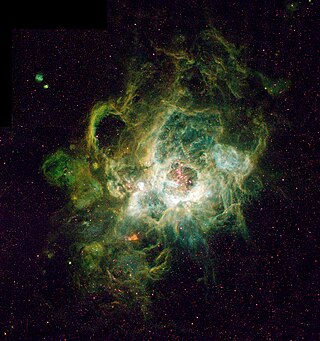
An H II region or HII region is a region of interstellar atomic hydrogen that is ionized. It is typically in a molecular cloud of partially ionized gas in which star formation has recently taken place, with a size ranging from one to hundreds of light years, and density from a few to about a million particles per cubic centimetre. The Orion Nebula, now known to be an H II region, was observed in 1610 by Nicolas-Claude Fabri de Peiresc by telescope, the first such object discovered.

The Trifid Nebula is an H II region in the north-west of Sagittarius in a star-forming region in the Milky Way's Scutum–Centaurus Arm. It was discovered by Charles Messier on June 5, 1764. Its name means 'three-lobe'. The object is an unusual combination of an open cluster of stars, an emission nebula, a reflection nebula, and a dark nebula. Viewed through a small telescope, the Trifid Nebula is a bright and peculiar object, and is thus a perennial favorite of amateur astronomers.

The Cat's Eye Nebula is a planetary nebula in the northern constellation of Draco, discovered by William Herschel on February 15, 1786. It was the first planetary nebula whose spectrum was investigated by the English amateur astronomer William Huggins, demonstrating that planetary nebulae were gaseous and not stellar in nature. Structurally, the object has had high-resolution images by the Hubble Space Telescope revealing knots, jets, bubbles and complex arcs, being illuminated by the central hot planetary nebula nucleus (PNN). It is a well-studied object that has been observed from radio to X-ray wavelengths.
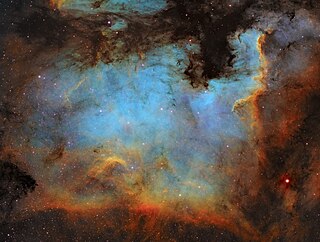
The North America Nebula is an emission nebula in the constellation Cygnus, close to Deneb. It is named because its shape resembles North America.

Centaurus A is a galaxy in the constellation of Centaurus. It was discovered in 1826 by Scottish astronomer James Dunlop from his home in Parramatta, in New South Wales, Australia. There is considerable debate in the literature regarding the galaxy's fundamental properties such as its Hubble type and distance. It is the closest radio galaxy to Earth, as well as the closest BL Lac object, so its active galactic nucleus has been extensively studied by professional astronomers. The galaxy is also the fifth-brightest in the sky, making it an ideal amateur astronomy target. It is only visible from the southern hemisphere and low northern latitudes.
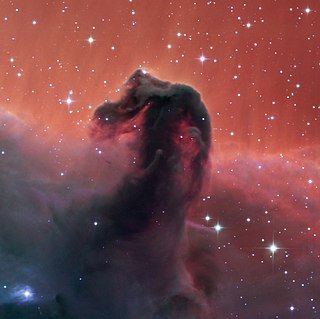
The Horsehead Nebula is a small dark nebula in the constellation Orion. The nebula is located just to the south of Alnitak, the easternmost star of Orion's Belt, and is part of the much larger Orion molecular cloud complex. It appears within the southern region of the dense dust cloud known as Lynds 1630, along the edge of the much larger, active star-forming H II region called IC 434.

The Whirlpool Galaxy, also known as Messier 51a (M51a) or NGC 5194, is an interacting grand-design spiral galaxy with a Seyfert 2 active galactic nucleus. It lies in the constellation Canes Venatici, and was the first galaxy to be classified as a spiral galaxy. It is 7.22 megaparsecs away and 23.58 kiloparsecs (76,900 ly) in diameter.

The Sombrero Galaxy is a peculiar galaxy of unclear classification in the constellation borders of Virgo and Corvus, being about 9.55 megaparsecs from the Milky Way galaxy. It is a member of the Virgo II Groups, a series of galaxies and galaxy clusters strung out from the southern edge of the Virgo Supercluster. It has an isophotal diameter of approximately 29.09 to 32.32 kiloparsecs, making it slightly bigger in size than the Milky Way.
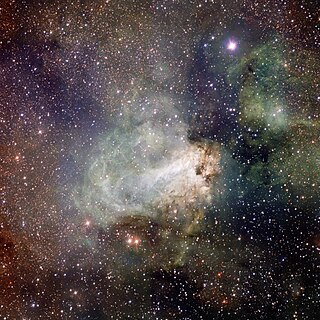
The Omega Nebula, also known as the Swan Nebula, Checkmark Nebula, Lobster Nebula, and the Horseshoe Nebula is an H II region in the constellation Sagittarius. It was discovered by Philippe Loys de Chéseaux in 1745. Charles Messier catalogued it in 1764. It is by some of the richest starfields of the Milky Way, figuring in the northern two-thirds of Sagittarius.

The Merope Nebula is a diffuse reflection nebula in the Pleiades star cluster, surrounding the 4th magnitude star Merope. It was discovered on October 19, 1859 by the German astronomer Wilhelm Tempel. The discovery was made using a 10.5 cm refractor. John Herschel included it as 768 in his General Catalogue of Nebulae and Clusters of Stars but never observed it himself.

NGC 7027, also known as the Jewel Bug Nebula or the Magic Carpet Nebula, is a very young and dense planetary nebula located around 3,000 light-years from Earth in the constellation Cygnus. Discovered in 1878 by Édouard Stephan using the 800 mm (31 in) reflector at Marseille Observatory, it is one of the smallest planetary nebulae and by far the most extensively studied.

R Monocerotis, abbreviated R Mon, is a very young binary star system in the equatorial constellation of Monoceros. The apparent magnitude of R Mon varies between 10 and 12 and the spectral type is B8IIIe.

Sh 2-279 is an HII region and bright nebulae that includes a reflection nebula located in the constellation Orion. It is the northernmost part of the asterism known as Orion's Sword, lying 0.6° north of the Orion Nebula. The reflection nebula embedded in Sh 2-279 is popularly known as the Running Man Nebula.
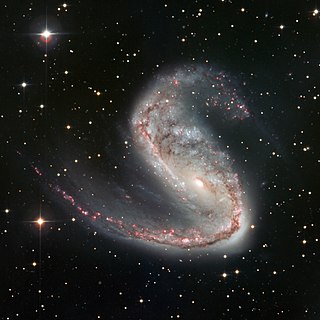
NGC 2442 and NGC 2443 are two parts of a single intermediate spiral galaxy, commonly known as the Meathook Galaxy or the Cobra and Mouse. It is about 50 million light-years away in the constellation Volans. It was discovered by Sir John Herschel on December 23, 1834 during his survey of southern skies with a 18.25 inch diameter reflecting telescope from an observatory he set up in Cape Town, South Africa. Associated with this galaxy is HIPASS J0731-69, a cloud of gas devoid of any stars. It is likely that the cloud was torn loose from NGC 2442 by a companion.

NGC 5307 is a planetary nebula in the southern constellation of Centaurus, positioned less than 3° to the northeast of the star Epsilon Centauri. It was discovered by English astronomer John Herschel on April 15, 1836. The nebula is located at a distance of approximately 10.6 kilolight-years from the Sun. The central star, designated PNG 312.3+10.5, is a weak emission-line star, superficially similar to the WC subtype of Wolf–Rayet stars. It has a spectral class of O(H)3.5 V.

Variable nebulae are reflection nebulae that change in brightness because of changes in their star.




















